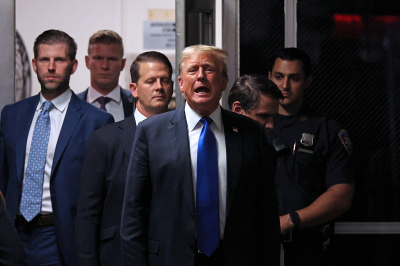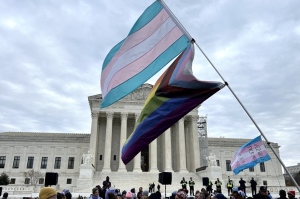The colossal travesty of the Trump trial

Imagine getting arrested for a felony, but the district attorney never specifies the more serious crime the charge is based on in the indictment.
Now, picture this: it’s the final week of your grueling six-week trial when, at last, the prosecution discloses the secondary crime. Turns out, the hyped-up crime is also a mere misdemeanor, resting on even more underlying offenses.
Then, the DA conjures up three different theories of what those underlying crimes could be to magically upgrade both misdemeanors to that vaunted felony.
Meanwhile, the judge instructs the jury to choose Theory A, B, or C for the underlying crimes of the second misdemeanor, which props up the first misdemeanor. In other words, the jurors aren’t compelled to agree on what the actual crime was — some can choose A, while others can choose B or C.
Fair? Due process? Presumption of innocence? Upholding the 6th Amendment’s guarantee “to be informed of the nature and cause of the accusation” made against you?
Please.
Yet that’s exactly what unfolded in the spurious conviction of Donald J. Trump. Predictably, a 12-member jury in deep blue Manhattan found the former president guilty of 34 felony counts for falsifying business records.
This absurdly high number — 34 — stems from a “hush money” payment, which is more commonly known as a “nuisance settlement” that celebrities typically make to dodge bad publicity. And it’s not illegal.
Each of those inflated charges carries a penalty for imprisonment, so yes, the presumptive GOP presidential candidate could be jailed by allies of his Democrat rival.
This is not justice.
It is, however, social justice, and what we can expect from leftist courts moving forward.
Lady Justice, a frequent figure at courthouses, wears a blindfold, illustrating her impartiality. She bears a sword in one hand and balances scales in the other, embodying the principle of fair and unbiased treatment under the law, regardless of one’s social status, race, creed, background, etc.
This concept of “equal justice” is firmly rooted in Scripture, such as Leviticus 19:15, which commands judges to treat the poor and the rich the same. Similarly, Proverbs 24:23 cautions against showing favoritism in judgment.
And while justice is upheld imperfectly, as it always will be, it’s still the standard for which we strive.
But social justice, on the other hand, isn’t blind.
With social justice, you’re already branded guilty, no matter the facts. If you’re white, you’re labeled an oppressor to be toppled. If you’re male, you’re deemed toxic and accused of crushing women. And if you’re Donald Trump, you’re just guilty because we despise your politics and will twist the law to convict you.
Remember, the district attorney, Alvin Bragg, got elected by vowing to hold Donald Trump “accountable.” That is to say, his mind was already made up prior to taking office.
Once elected, Bragg hit a snag. He couldn’t find a felony to nail Trump on, so he cooked up the “novel” theory of trying him on what the Wall Street Journal called “a bizarre turducken, with alleged crimes stuffed inside other crimes.”
How bizarre?
Well, Bragg “settled on a New York election law, rarely enforced, that prohibits conspiracies to promote political candidates ‘by unlawful means.’”
Note that this allegation was nowhere in the original indictment, even though it was what catapulted the ledger of “legal services” into 34 felony counts for falsifying business records.
And still, that’s not the whole grotesque story. The secondary crime, which we are told is foundational to the primary crime, is also a misdemeanor, and it, too, must have underlying crimes that make it a prosecutable offense.
If you’re getting confused, that’s okay; it’s why the indictment was dubbed “novel” (read: unfounded). We have one primary crime (the alleged “hush money” misclassification) with two underlying sets of crimes, both of which are dependent on each other to make the first one a felony.
So how did Trump promote his candidacy through “unlawful means,” according to Bragg’s team?
“First, the hush money was effectively an illegally large donation to Mr. Trump’s campaign. Second, more business filings were falsified, including bank records for Mr. Cohen’s wire transfer to Ms. Daniels. Third, false statements were made to tax authorities, since Mr. Trump’s repayment of Mr. Cohen was structured as income and ‘grossed up’ to cover the taxes he would need to pay on it.”
As the Journal sarcastically intones, “Did Mr. Trump falsify business records in 2017 to cover up an illegal conspiracy to elect him in 2016, whose unlawful means included false information in Mr. Cohen’s tax return for 2017?”
It gets worse though — Judge Juan Merchan, himself a Biden donor, instructed the jury that “they didn’t all have to agree about which theory of the ‘unlawful means’ they found persuasive.”
Some jurors may have picked the first or second allegation, and others could’ve gone with the third. The basic standard of unanimity in verdicts was tossed aside. We may never know who chose what.
Juries get it wrong all the time, and that will continue to happen. But what makes this case so abominable is that the jury, the judge, and the prosecutor were all in cahoots to punish a political rival out in the open.
That’s why you’ve heard warnings like “the Rubicon has been crossed,” signaling there’s no turning back.
This is what social justice leads to — not a presumption of innocence, but a presumption of punishment.
You don’t have to like Donald Trump and can acknowledge his character flaws and political liabilities, but this conviction was completely baseless and a colossal travesty.
Originally published at the Standing for Freedom Center.




























